 Characters in Joaquim Maria Machado de Assis stories often have a causa secreta (ulterior motive) for their actions. When a young doctor opens a hospital in partnership with a forty-year-old acquaintance, he is amazed by the older man’s dedication to nursing the most seriously ill and injured patients. A visit to his partner’s house explains why. He is a sadist who finds pleasure in inflicting pain on animals and observing the suffering of others. The doctor suppresses a growing love for the man’s frightened wife, only letting it show on her deathbed. Themes include sadism, cruelty, and secret love. More…
Characters in Joaquim Maria Machado de Assis stories often have a causa secreta (ulterior motive) for their actions. When a young doctor opens a hospital in partnership with a forty-year-old acquaintance, he is amazed by the older man’s dedication to nursing the most seriously ill and injured patients. A visit to his partner’s house explains why. He is a sadist who finds pleasure in inflicting pain on animals and observing the suffering of others. The doctor suppresses a growing love for the man’s frightened wife, only letting it show on her deathbed. Themes include sadism, cruelty, and secret love. More…
Category Archives: Short Stories
Dahong Palay
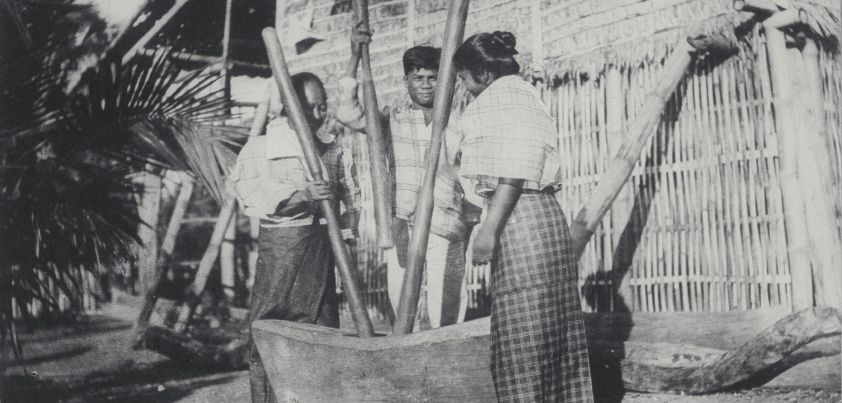 The Filipino term dahong palay has several meanings: a rice leaf, a single edged sword and, as in this story by Arturo B. Rotor, a deadly viper. A young man is the butt of constant jokes about his timid nature and slight build. An attempt to prove himself at a community rice-pounding gathering leads to further ridicule. Later, when bitten by a dahong palay to save his prospective girlfriend, he proves that resourcefulness, strength and courage aren’t dependent upon how well-built you are. Themes: community, body image, bullying, young love, courage. More…
The Filipino term dahong palay has several meanings: a rice leaf, a single edged sword and, as in this story by Arturo B. Rotor, a deadly viper. A young man is the butt of constant jokes about his timid nature and slight build. An attempt to prove himself at a community rice-pounding gathering leads to further ridicule. Later, when bitten by a dahong palay to save his prospective girlfriend, he proves that resourcefulness, strength and courage aren’t dependent upon how well-built you are. Themes: community, body image, bullying, young love, courage. More…
Filial Sentiments of a Parricide
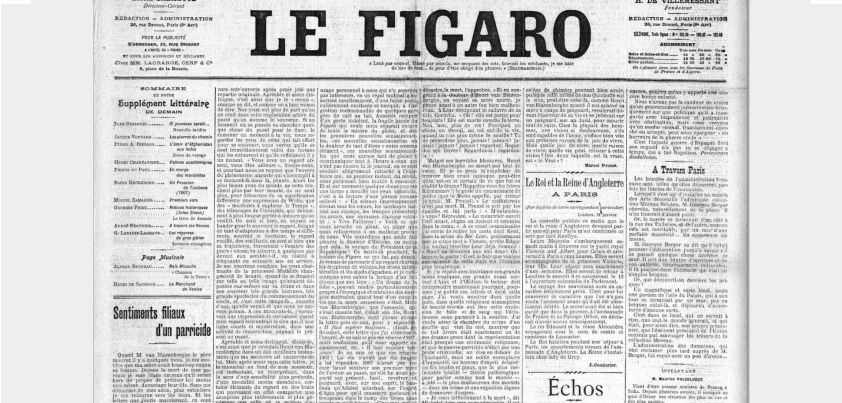 Filial parricide is the murder of a parent by a son or daughter. This story by Marcel Proust, originally published as a newspaper article and full of classic literary references, discusses a parricide-suicide committed by a highly respected French businessman. Written shortly after the death of Proust’s mother, he philosophizes about memories, the nature of death, the observation that all children commit a slow form of parricide through the anxiety and pain they cause their parents, and the question of whether, if they knew this, some may feel that life is worth living. Themes include memory, death, madness, parent-child relationships. More…
Filial parricide is the murder of a parent by a son or daughter. This story by Marcel Proust, originally published as a newspaper article and full of classic literary references, discusses a parricide-suicide committed by a highly respected French businessman. Written shortly after the death of Proust’s mother, he philosophizes about memories, the nature of death, the observation that all children commit a slow form of parricide through the anxiety and pain they cause their parents, and the question of whether, if they knew this, some may feel that life is worth living. Themes include memory, death, madness, parent-child relationships. More…
Signs and Symbols
 Vladimir Nabokov once indicated that Signs and Symbols contains a second story hidden behind various textual clues. The frame story, which involves an elderly couple’s dilemma about how to deal with their institutionalized mentally ill son, is a moving piece of dramatic prose in its own right. The supposed inner story has been the subject of much speculation. So far, nobody has convincingly decoded it. Perhaps there is none, Nabokov’s intention being to encourage readers to pay more attention to the signs and symbols in their own lives. Themes include mental illness, alienation, misfortune, suffering, poverty, death, parental love, hope. More…
Vladimir Nabokov once indicated that Signs and Symbols contains a second story hidden behind various textual clues. The frame story, which involves an elderly couple’s dilemma about how to deal with their institutionalized mentally ill son, is a moving piece of dramatic prose in its own right. The supposed inner story has been the subject of much speculation. So far, nobody has convincingly decoded it. Perhaps there is none, Nabokov’s intention being to encourage readers to pay more attention to the signs and symbols in their own lives. Themes include mental illness, alienation, misfortune, suffering, poverty, death, parental love, hope. More…
An Occurrence at Owl Creek Bridge
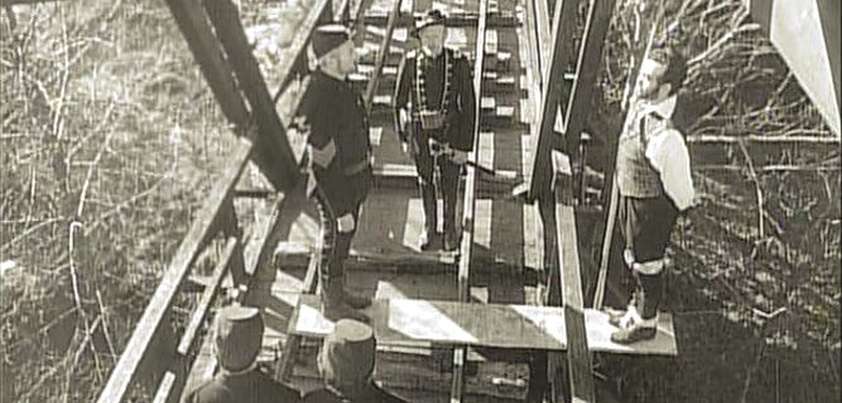 This Ambrose Bierce story contains some of the best descriptive language in American literature… so much so that most people will need to read the passage at least twice in order to properly appreciate it. All I can say about the plot without spoiling the experience for those who haven’t read it is that the surprise ending usually sticks in reader’s minds for some time. The major themes: sense of duty; love and sacrifice; the brutality of war; confronting death; near-death experiences; and time (the length of a moment) as reflected in the personification metaphor time stood still. More…
This Ambrose Bierce story contains some of the best descriptive language in American literature… so much so that most people will need to read the passage at least twice in order to properly appreciate it. All I can say about the plot without spoiling the experience for those who haven’t read it is that the surprise ending usually sticks in reader’s minds for some time. The major themes: sense of duty; love and sacrifice; the brutality of war; confronting death; near-death experiences; and time (the length of a moment) as reflected in the personification metaphor time stood still. More…
A Problem
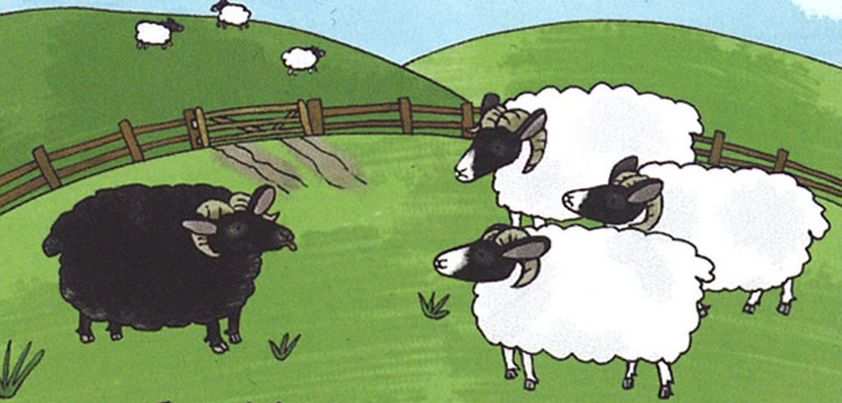 In this Anton Chekhov story, wealthy family members consider what to do about a nephew who has issued a false promissory note (IOU) in one of their names. Do they repay the debt to preserve family honor and avoid a scandal, or let justice take its course? On learning of the decision, the unscrupulous young man uses it to extort further money from an uncle trying to help him and, in the process, grudgingly admits an unfortunate aspect of his character. Themes: crime and consequences; justice/civic duty vs. family honor; nature vs. nurture, hedonism of the young upper-class, pride, despair. More…
In this Anton Chekhov story, wealthy family members consider what to do about a nephew who has issued a false promissory note (IOU) in one of their names. Do they repay the debt to preserve family honor and avoid a scandal, or let justice take its course? On learning of the decision, the unscrupulous young man uses it to extort further money from an uncle trying to help him and, in the process, grudgingly admits an unfortunate aspect of his character. Themes: crime and consequences; justice/civic duty vs. family honor; nature vs. nurture, hedonism of the young upper-class, pride, despair. More…
The Purloined Letter
 Edgar Allan Poe is famous for his horror stories. However, only about fifteen of his sixty or so stories are of this kind.He is also widely recognized as the “father” of modern detective fiction thanks to his three tales featuring the Chevalier [Sir] Auguste Dupin. In a manner later emulated by the likes of Sherlock Holmes and Hercule Poirot, Dupin succeeds where eminent policemen fail… in this case, simply by recognizing that the best place to hide something important is in plain sight. Themes: blackmail, political manipulation, deception, linear (scientific) vs. lateral thinking. More…
Edgar Allan Poe is famous for his horror stories. However, only about fifteen of his sixty or so stories are of this kind.He is also widely recognized as the “father” of modern detective fiction thanks to his three tales featuring the Chevalier [Sir] Auguste Dupin. In a manner later emulated by the likes of Sherlock Holmes and Hercule Poirot, Dupin succeeds where eminent policemen fail… in this case, simply by recognizing that the best place to hide something important is in plain sight. Themes: blackmail, political manipulation, deception, linear (scientific) vs. lateral thinking. More…
Mrs. Geni in December
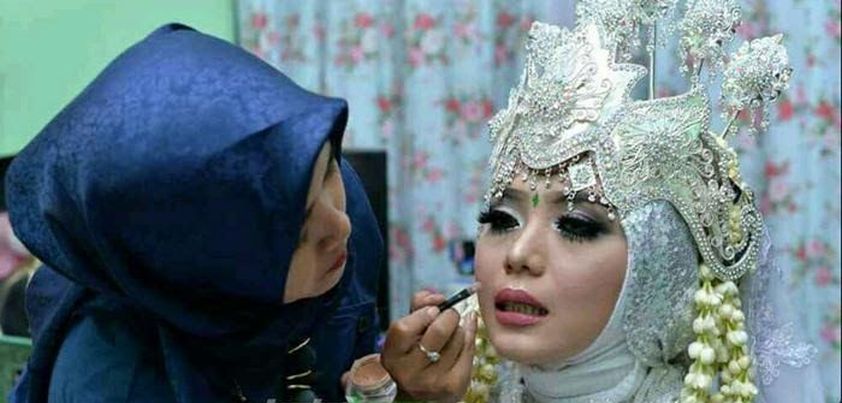 This story by Arswendo Atmowiloto explores the life of an eccentric Indonesian bridal make-up artist. While some of her views reflect Indonesia’s Muslim culture (marrying when it is time, not of love, and support for polygyny), others challenge it (pregnant brides should be proud of their proven fertility and not hide the fact). She believes that while marriage is illogical and “humanity’s most restricting and frightening discovery”, the ceremony brings joy and happiness. She proclaims: “Let people experience joy once in their lives,” implying the ceremony may mark the end of their happiness. Themes include marriage, freedom and happiness. More…
This story by Arswendo Atmowiloto explores the life of an eccentric Indonesian bridal make-up artist. While some of her views reflect Indonesia’s Muslim culture (marrying when it is time, not of love, and support for polygyny), others challenge it (pregnant brides should be proud of their proven fertility and not hide the fact). She believes that while marriage is illogical and “humanity’s most restricting and frightening discovery”, the ceremony brings joy and happiness. She proclaims: “Let people experience joy once in their lives,” implying the ceremony may mark the end of their happiness. Themes include marriage, freedom and happiness. More…
End of the Game
 This Julio Cortázar story involves two “games”. One is the daily Statues role-play three adolescent girls perform to entertain passengers on a passing train. The second is also a game of pretend… ignoring the effect a debilitating disability will have on one of their lives. For the disabled girl (Letitia), Statues is the only physical activity in which she can match the others. They in turn are resentful of Letitia’s special treatment at home. When a boy on the train takes a special interest in Letitia, both games end. Themes: fantasy vs. reality, envy, guilt, confronting disability, coming of age. More…
This Julio Cortázar story involves two “games”. One is the daily Statues role-play three adolescent girls perform to entertain passengers on a passing train. The second is also a game of pretend… ignoring the effect a debilitating disability will have on one of their lives. For the disabled girl (Letitia), Statues is the only physical activity in which she can match the others. They in turn are resentful of Letitia’s special treatment at home. When a boy on the train takes a special interest in Letitia, both games end. Themes: fantasy vs. reality, envy, guilt, confronting disability, coming of age. More…
The Drummer Boy of Shiloh
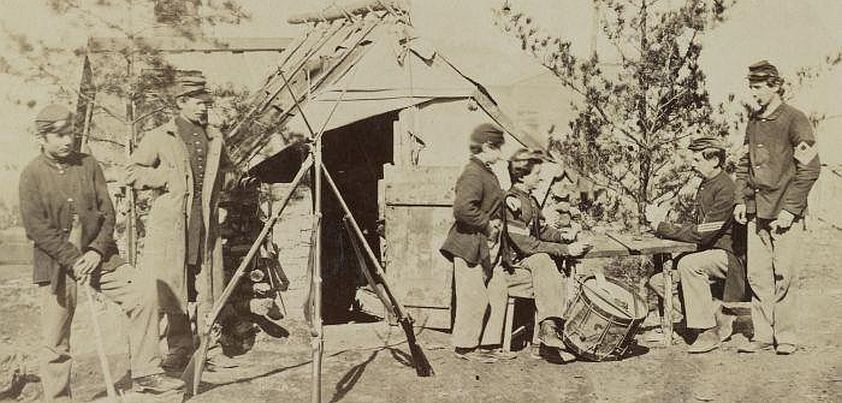 This story by Ray Bradbury packs a lot of raw emotion, even though the “action” is limited to a single conversation that takes place over the course of no more than half an hour. A fourteen-year-old drummer boy who must march into battle with no gun or means of protecting himself is a bundle of nerves on the night before his first encounter with the enemy. An inspirational talk with his commanding general teaches him that his drum may be one of the most effective weapons in the army. Themes include isolation and loneliness, empathy, duty, fear, courage, death, honor. More…
This story by Ray Bradbury packs a lot of raw emotion, even though the “action” is limited to a single conversation that takes place over the course of no more than half an hour. A fourteen-year-old drummer boy who must march into battle with no gun or means of protecting himself is a bundle of nerves on the night before his first encounter with the enemy. An inspirational talk with his commanding general teaches him that his drum may be one of the most effective weapons in the army. Themes include isolation and loneliness, empathy, duty, fear, courage, death, honor. More…
Flowering Judas
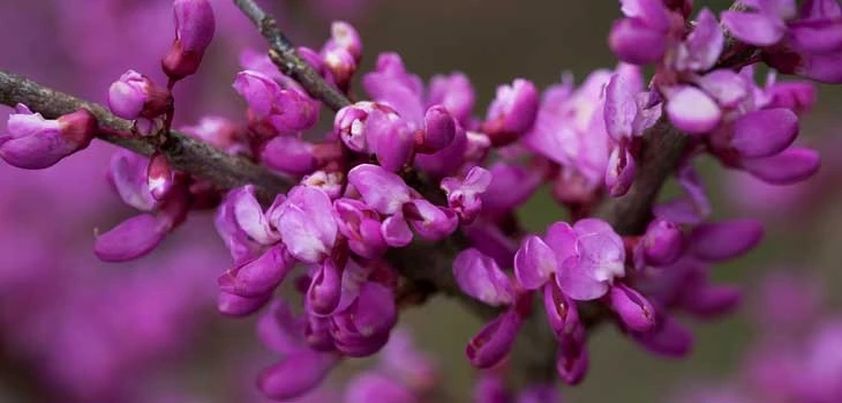 The major theme of this story by Katherine Porter is betrayal. Other themes include alienation, fear, corruption, despair and guilt. Laura, an idealistic American schoolteacher who traveled to Mexico to support the socialist revolution has a sense of impending doom. Trapped by the unwanted attentions of the corrupt, adulterous revolutionary Braggioni and with no love for the Mexican people, she feels lost and alone. Braggioni’s lifestyle is a betrayal of both his socialist ideals and marriage. In working for a socialist cause, Laura betrays her Catholic faith. Her sexual repression could also be seen as betrayal of her womanhood. More…
The major theme of this story by Katherine Porter is betrayal. Other themes include alienation, fear, corruption, despair and guilt. Laura, an idealistic American schoolteacher who traveled to Mexico to support the socialist revolution has a sense of impending doom. Trapped by the unwanted attentions of the corrupt, adulterous revolutionary Braggioni and with no love for the Mexican people, she feels lost and alone. Braggioni’s lifestyle is a betrayal of both his socialist ideals and marriage. In working for a socialist cause, Laura betrays her Catholic faith. Her sexual repression could also be seen as betrayal of her womanhood. More…
The Ransom of Red Chief
 In this story by O. Henry, two bumbling swindlers kidnap a boy to raise money for their next scam. Unfortunately, they choose the wrong victim. Not only is the boy hyperactive and uncontrollable but, poorly treated at home, he enjoys camping out with them so much that he doesn’t want to return. Through various persona (including the warrior Red Chief), he drives the men to distraction … so much so that when his father refuses to pay their ransom, they pay him to take the boy back. Themes include crime, parental neglect, misjudgement, imagination and make-believe, violence, poetic justice. More…
In this story by O. Henry, two bumbling swindlers kidnap a boy to raise money for their next scam. Unfortunately, they choose the wrong victim. Not only is the boy hyperactive and uncontrollable but, poorly treated at home, he enjoys camping out with them so much that he doesn’t want to return. Through various persona (including the warrior Red Chief), he drives the men to distraction … so much so that when his father refuses to pay their ransom, they pay him to take the boy back. Themes include crime, parental neglect, misjudgement, imagination and make-believe, violence, poetic justice. More…
Secretary
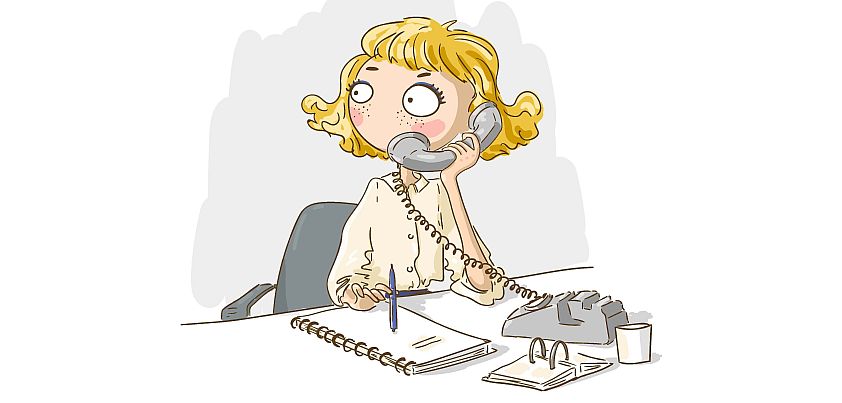 In this story by Mary Gaitskill an insecure, introverted young woman from a dysfunctional family begins her first ever job as a secretary in a lawyer’s office. Unfortunately, her employer is a sadistic sexual predator. After several weeks of repeated spelling mistakes in letters she types, he calls her into his office and spanks her. She is both repulsed and sexually stimulated by the humiliation. She quits the job when he goes a step further and, after responding to the degradation by pleasuring herself, the poor woman suffers an emotional breakdown. Themes include innocence, sexuality, workplace harassment, sexual assault, BDSM. More…
In this story by Mary Gaitskill an insecure, introverted young woman from a dysfunctional family begins her first ever job as a secretary in a lawyer’s office. Unfortunately, her employer is a sadistic sexual predator. After several weeks of repeated spelling mistakes in letters she types, he calls her into his office and spanks her. She is both repulsed and sexually stimulated by the humiliation. She quits the job when he goes a step further and, after responding to the degradation by pleasuring herself, the poor woman suffers an emotional breakdown. Themes include innocence, sexuality, workplace harassment, sexual assault, BDSM. More…
The Drover’s Wife
 In this story by Henry Lawson, a woman remembers the many hardships and few good times in her life as she sits up all night with only a dog to help protect her and her children from a deadly snake. The snake has crawled under their house. They can’t sleep inside, as the wooden floor has gaps in it. They cower in the kitchen, which is attached to the side of the house and has an earthen floor. The children sleep on the table. She sits on a chair with a stick on her lap, waiting for the snake. More…
In this story by Henry Lawson, a woman remembers the many hardships and few good times in her life as she sits up all night with only a dog to help protect her and her children from a deadly snake. The snake has crawled under their house. They can’t sleep inside, as the wooden floor has gaps in it. They cower in the kitchen, which is attached to the side of the house and has an earthen floor. The children sleep on the table. She sits on a chair with a stick on her lap, waiting for the snake. More…
Mateo Falcone
 This disturbing tale by Prosper Mérimée has been called “the cruellest story in the world”. Although it deals with some complex issues, the plot is rather simple. Set in the wilds of Corsica, a bratty ten-year-old boy left home alone is confronted by a wounded criminal fleeing the police. He pays the boy to hide him but, when the police arrive and offer a bigger reward, the boy betrays the man. This brings shame upon his family, and forces his father to enforce the Corsican Code of Honor. Themes include greed, honor and betrayal, custom (vendetta), violence and brutality. More…
This disturbing tale by Prosper Mérimée has been called “the cruellest story in the world”. Although it deals with some complex issues, the plot is rather simple. Set in the wilds of Corsica, a bratty ten-year-old boy left home alone is confronted by a wounded criminal fleeing the police. He pays the boy to hide him but, when the police arrive and offer a bigger reward, the boy betrays the man. This brings shame upon his family, and forces his father to enforce the Corsican Code of Honor. Themes include greed, honor and betrayal, custom (vendetta), violence and brutality. More…
Luck
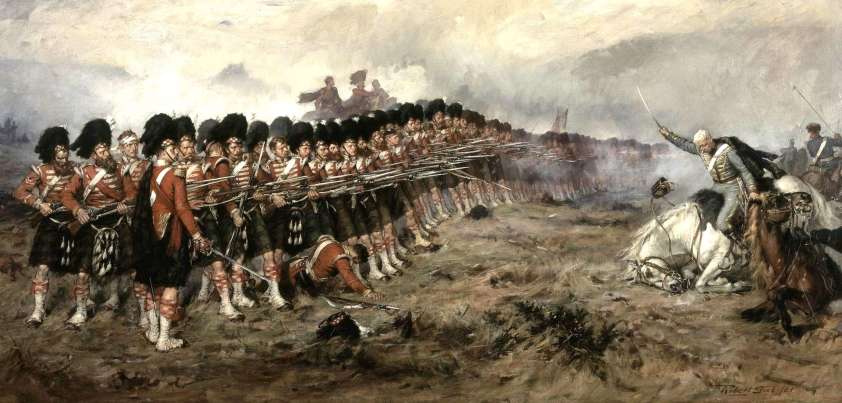 As the name implies, the major theme of Luck by Samuel Clemens (aka Mark Twain) is just that — Luck! Its main message is that good fortune can result in the most unlikely people achieving greatness. Other themes include envy and injustice. The clergyman envies Lieutenant General Lord Arthur Scoresby, V.C., K.C.B., etc. for his successes in life… especially on the battlefield where, in reality, he didn’t seem to know back from forwards and right from left. There is also a sense of injustice in that the General appears to show no appreciation for the clergyman’s role in his success. More…
As the name implies, the major theme of Luck by Samuel Clemens (aka Mark Twain) is just that — Luck! Its main message is that good fortune can result in the most unlikely people achieving greatness. Other themes include envy and injustice. The clergyman envies Lieutenant General Lord Arthur Scoresby, V.C., K.C.B., etc. for his successes in life… especially on the battlefield where, in reality, he didn’t seem to know back from forwards and right from left. There is also a sense of injustice in that the General appears to show no appreciation for the clergyman’s role in his success. More…
Guests of the Nation
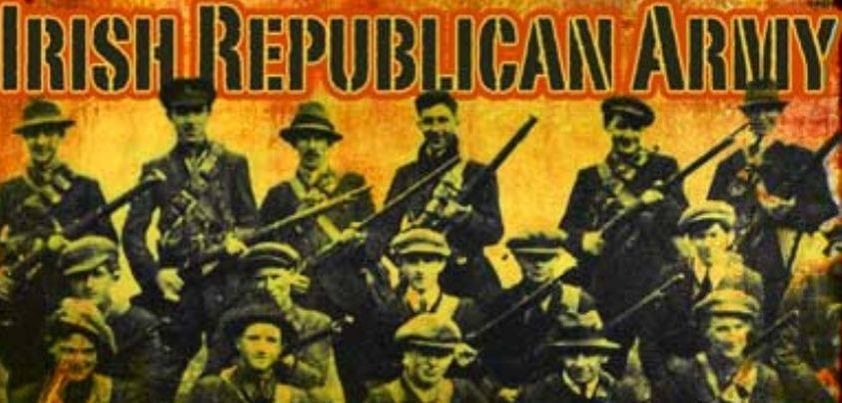 This story by Frank O’Connor takes place during, or possibly shortly after, the Irish War of Independence of 1919-1921. Two young Irishmen become friends with two English ‘prisoners’ they are guarding. That is until a cold-hearted officer orders them to take part in the execution of the two men. As one notes at the end of the story: And anything that happened to me afterwards, I never felt the same about again. Themes: friendship, religion vs. atheism, choices and consequences, aspects of war (duty vs. morality, brutality, the humanity of enemy combatants, possible long-term psychological effects). More…
This story by Frank O’Connor takes place during, or possibly shortly after, the Irish War of Independence of 1919-1921. Two young Irishmen become friends with two English ‘prisoners’ they are guarding. That is until a cold-hearted officer orders them to take part in the execution of the two men. As one notes at the end of the story: And anything that happened to me afterwards, I never felt the same about again. Themes: friendship, religion vs. atheism, choices and consequences, aspects of war (duty vs. morality, brutality, the humanity of enemy combatants, possible long-term psychological effects). More…
An Astrologer’s Day
 The “astrologer” in this story by R. K. Narayan is a fake, making a living by knowing enough about human nature to trick people into believing he has mystical powers. One day, he bargains with a reluctant passer-by to answer a question for many times his usual fee. He tries to cancel the reading immediately the passer-by sits down, but the man forcibly insists he continues. Although a deliberate lie, his answer not only eases the tormented man’s mind, but also brings in peace and redemption to himself. Themes include deception, fate, crime and punishment, revenge, redemption, spirituality, greed. More…
The “astrologer” in this story by R. K. Narayan is a fake, making a living by knowing enough about human nature to trick people into believing he has mystical powers. One day, he bargains with a reluctant passer-by to answer a question for many times his usual fee. He tries to cancel the reading immediately the passer-by sits down, but the man forcibly insists he continues. Although a deliberate lie, his answer not only eases the tormented man’s mind, but also brings in peace and redemption to himself. Themes include deception, fate, crime and punishment, revenge, redemption, spirituality, greed. More…
The Falling Girl
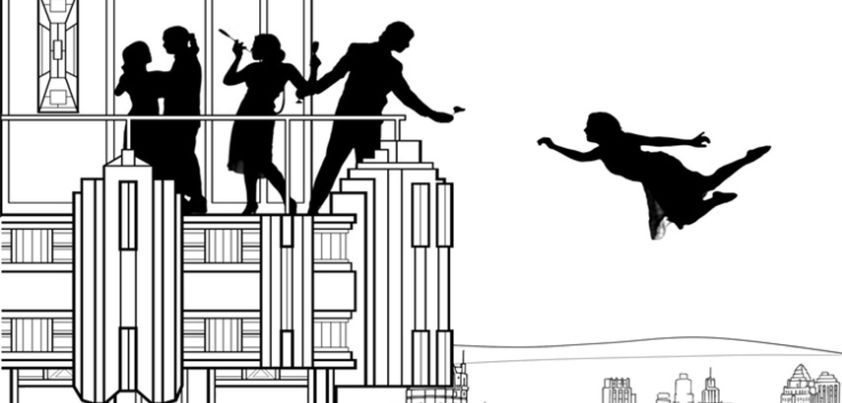 The meaning of this thought-provoking story by Dino Buzzati is reflected in both the building and the girl. The skyscraper is a metaphor for society: the idle rich party at the “top”, as the working class scurry about at the bottom. The story represents an attractive young woman’s journey from the glamor and excitement of the “high life” to the loneliness, frailty and fears of old age. In the sad conclusion, she has no one to mourn her (hear the “thud”) when she hits the ground. Themes include social class, consumerism, envy, lack of fulfilment, ageing, alienation and loneliness. More…
The meaning of this thought-provoking story by Dino Buzzati is reflected in both the building and the girl. The skyscraper is a metaphor for society: the idle rich party at the “top”, as the working class scurry about at the bottom. The story represents an attractive young woman’s journey from the glamor and excitement of the “high life” to the loneliness, frailty and fears of old age. In the sad conclusion, she has no one to mourn her (hear the “thud”) when she hits the ground. Themes include social class, consumerism, envy, lack of fulfilment, ageing, alienation and loneliness. More…
Greyhound People
 This story by Alice Adams consists of several “snapshots” of the narrator’s encounters with fellow passengers on Greyhound buses. Recently divorced and facing potential homelessness, the woman’s self-esteem is at an all-time low. Taken in by an overbearing friend, her life has deteriorated into a daily grind. Faced with an inter-city bus commute morning and evening, the situations she encounters and people she meets awaken her to a whole new world. For perhaps the first time in her life, she begins to act independently and step out of her comfort zone. Themes: isolation, insecurity, friendship, dependency, anxiety/fear, personal growth. More…
This story by Alice Adams consists of several “snapshots” of the narrator’s encounters with fellow passengers on Greyhound buses. Recently divorced and facing potential homelessness, the woman’s self-esteem is at an all-time low. Taken in by an overbearing friend, her life has deteriorated into a daily grind. Faced with an inter-city bus commute morning and evening, the situations she encounters and people she meets awaken her to a whole new world. For perhaps the first time in her life, she begins to act independently and step out of her comfort zone. Themes: isolation, insecurity, friendship, dependency, anxiety/fear, personal growth. More…
The Duchess and the Jeweller
 This story by Virginia Woolf reflects the period in which the moral decadence of British aristocracy led to its loss of respect among the people and the rising influence of newly rich commoners. It also shows how both groups could be equally ruthless in achieving their goals. The Duchess represents the aristocracy, corruptly trying to sell a fake set of pearls by taking advantage of the Jeweller’s interest in her daughter. The Jeweller represents the newly rich, craving social acceptance and willing to waste £20,000 buying fake pearls to achieve it. Themes include greed, vanity, social class, appearance, deception, racism. More…
This story by Virginia Woolf reflects the period in which the moral decadence of British aristocracy led to its loss of respect among the people and the rising influence of newly rich commoners. It also shows how both groups could be equally ruthless in achieving their goals. The Duchess represents the aristocracy, corruptly trying to sell a fake set of pearls by taking advantage of the Jeweller’s interest in her daughter. The Jeweller represents the newly rich, craving social acceptance and willing to waste £20,000 buying fake pearls to achieve it. Themes include greed, vanity, social class, appearance, deception, racism. More…
The Ambitious Guest
 Based on a true event, this Nathaniel Hawthorne story illustrates the power of nature and the futility of man in trying to best it. A young man stops at an inn high on a mountain pass and boasts to the family inside about his ambition to do something great to be remembered by. Above the inn are towering mountains from which rocks and boulders are frequently dislodged. The family have built a safe house nearby in the event of an avalanche, but when the ‘slide’ comes, nature wins. Other themes include hubris, ambition, contentment, connection, fate. More…
Based on a true event, this Nathaniel Hawthorne story illustrates the power of nature and the futility of man in trying to best it. A young man stops at an inn high on a mountain pass and boasts to the family inside about his ambition to do something great to be remembered by. Above the inn are towering mountains from which rocks and boulders are frequently dislodged. The family have built a safe house nearby in the event of an avalanche, but when the ‘slide’ comes, nature wins. Other themes include hubris, ambition, contentment, connection, fate. More…
Civil Peace
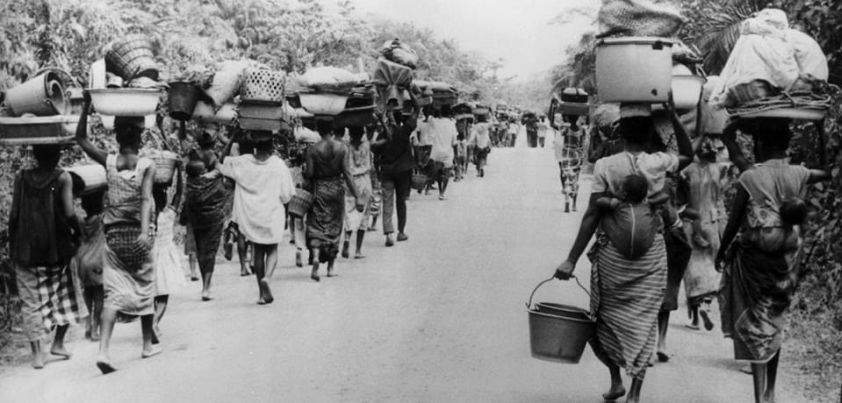 On the surface, Chinua Achebe’s Civil Peace appears to be a light-hearted take on the challenges faced by a family in the aftermath of the Nigerian Civil War. In reality, it deals with the much darker themes of corruption, devastation and lawlessness, as well as the positive themes of being thankful for what you have, finding opportunity in adversity, hard work, family unity, and the resilience of the human spirit in times of extreme difficulty. Another theme, common in the third-world and reflected in the frequently repeated Nothing puzzels God!, is that everything that happens is part of God’s plan. More…
On the surface, Chinua Achebe’s Civil Peace appears to be a light-hearted take on the challenges faced by a family in the aftermath of the Nigerian Civil War. In reality, it deals with the much darker themes of corruption, devastation and lawlessness, as well as the positive themes of being thankful for what you have, finding opportunity in adversity, hard work, family unity, and the resilience of the human spirit in times of extreme difficulty. Another theme, common in the third-world and reflected in the frequently repeated Nothing puzzels God!, is that everything that happens is part of God’s plan. More…
Look at All Those Roses
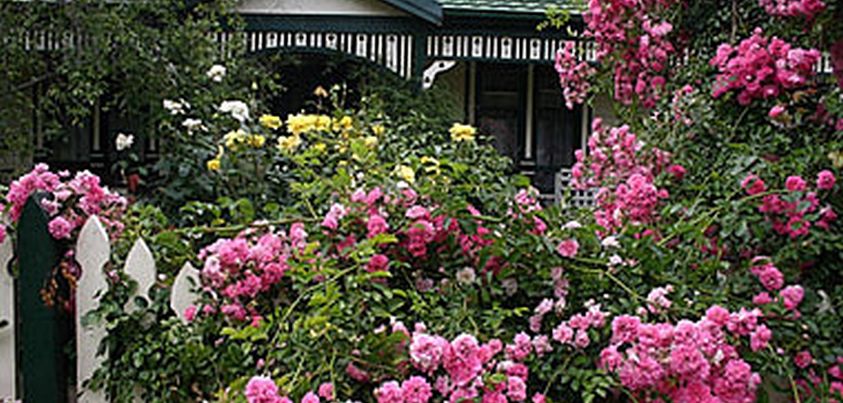 In this story by Elizabeth Bowen, car trouble on a deserted country road results in a woman spending several unsettling hours with an amazon of a woman and her seemingly psychic, paralyzed daughter. Her partner has walked to a nearby village to get help, and she becomes increasingly anxious. She falls asleep, and is in the middle of a disturbing dream when her partner returns in a taxi and rudely whisks her away. While in the village, he had heard a frightening rumor about the family. Themes include isolation and alienation, insecurity, emptiness, alternative reality (the white circle), rumor. More…
In this story by Elizabeth Bowen, car trouble on a deserted country road results in a woman spending several unsettling hours with an amazon of a woman and her seemingly psychic, paralyzed daughter. Her partner has walked to a nearby village to get help, and she becomes increasingly anxious. She falls asleep, and is in the middle of a disturbing dream when her partner returns in a taxi and rudely whisks her away. While in the village, he had heard a frightening rumor about the family. Themes include isolation and alienation, insecurity, emptiness, alternative reality (the white circle), rumor. More…
Farewell to a Ghost
 Although one of the main characters is a ghost, this story by Manoj Das is not a horror story. An unfortunate ghost in a deserted villa has become an integral part of life in an Indian village. The government plans to demolish the villa to pay its taxes, and the villagers must try to relocate the ghost so that it doesn’t try to resettle in someone’s house. Themes include coming of age, the important role of superstition in traditional village culture, and the impact of modern ideas in changing traditional values and beliefs. More…
Although one of the main characters is a ghost, this story by Manoj Das is not a horror story. An unfortunate ghost in a deserted villa has become an integral part of life in an Indian village. The government plans to demolish the villa to pay its taxes, and the villagers must try to relocate the ghost so that it doesn’t try to resettle in someone’s house. Themes include coming of age, the important role of superstition in traditional village culture, and the impact of modern ideas in changing traditional values and beliefs. More…
Dante and the Lobster
 As suggested in the title, this early story by Samuel Beckett contains several allusions to Dante’s Divine Comedy. Unfortunately, some of its nuances will be lost on readers unfamiliar with this work. Hidden among the allusions is an absurdist comedy spanning an afternoon in the life of a solitary, eccentric student having trouble with his studies. He is selfish and conceited, fanatical about unimportant things (such as making the perfect toasted sandwich), and apathetic towards things that matter (his studies, politeness, compassion.) Themes include sloth, frustration, the meaningless and futility of life, suffering and death. More…
As suggested in the title, this early story by Samuel Beckett contains several allusions to Dante’s Divine Comedy. Unfortunately, some of its nuances will be lost on readers unfamiliar with this work. Hidden among the allusions is an absurdist comedy spanning an afternoon in the life of a solitary, eccentric student having trouble with his studies. He is selfish and conceited, fanatical about unimportant things (such as making the perfect toasted sandwich), and apathetic towards things that matter (his studies, politeness, compassion.) Themes include sloth, frustration, the meaningless and futility of life, suffering and death. More…
Night Driver
 In Italo Calvino’s Night Driver, a man speeds to his girlfriend’s house to apologize about a phone argument during which he called off their relationship. He needs to get there quickly, because she threatened to call a rival. He faces two problems in getting there on time: 1) they live far apart, so it is a long drive; and 2) he thinks too much. As he drives, the man examines every possibility as to what the other two may be doing, whether one or both could also be driving along the same highway, and what other steps he should take. More…
In Italo Calvino’s Night Driver, a man speeds to his girlfriend’s house to apologize about a phone argument during which he called off their relationship. He needs to get there quickly, because she threatened to call a rival. He faces two problems in getting there on time: 1) they live far apart, so it is a long drive; and 2) he thinks too much. As he drives, the man examines every possibility as to what the other two may be doing, whether one or both could also be driving along the same highway, and what other steps he should take. More…
The Cone
 When the manager of an iron-works takes an artist friend he knows to be sleeping with his wife on a tour of the furnaces, it seems inevitable that one of them will meet with an unfortunate ‘accident’. The power of this H. G. Wells story lies in its gradual build-up of suspense and vivid descriptions of the industrial landscape and smelting process. Major themes are adultery, revenge, violence and (for modern-day readers) environmental degradation. Ironically, when the story was published in 1895, readers would have identified the fourth theme as something akin to ‘progress’. More…
When the manager of an iron-works takes an artist friend he knows to be sleeping with his wife on a tour of the furnaces, it seems inevitable that one of them will meet with an unfortunate ‘accident’. The power of this H. G. Wells story lies in its gradual build-up of suspense and vivid descriptions of the industrial landscape and smelting process. Major themes are adultery, revenge, violence and (for modern-day readers) environmental degradation. Ironically, when the story was published in 1895, readers would have identified the fourth theme as something akin to ‘progress’. More…
The Three Hermits
 In this story by Leo Tolstoy, a bishop of the Roman Orthodox Church schools three devout hermits seeking salvation by living alone on a deserted island in reciting the Lord’s Prayer. He claims that although that their own prayer ‘Three are ye, three are we, have mercy upon us.’ encompasses the essence of Christianity, it is insufficient to please God. The bishop is humbled and admits his mistake when they miraculously follow him by gliding across the sea, having forgotten the words. Themes include humility and devotion, religious dogma vs. faith, the nature of prayer. More…
In this story by Leo Tolstoy, a bishop of the Roman Orthodox Church schools three devout hermits seeking salvation by living alone on a deserted island in reciting the Lord’s Prayer. He claims that although that their own prayer ‘Three are ye, three are we, have mercy upon us.’ encompasses the essence of Christianity, it is insufficient to please God. The bishop is humbled and admits his mistake when they miraculously follow him by gliding across the sea, having forgotten the words. Themes include humility and devotion, religious dogma vs. faith, the nature of prayer. More…
A Horse in the Moon
 This story by Luigi Pirandello opens with a wedding feast in which guests are concerned for the innocent, vivacious Italian bride. Although wealthy, the Sicilian groom appears physically and mentally ill. After seeing the guests off, the groom tries to hurry his new wife inside. She objects and, while heading towards the nearby village, they come across a dying horse. On seeing his reaction, she realizes the marriage was a mistake. A medical episode and vision he has as the moon rises behind the horse solves the problem for her. Themes include naivety, marriage, madness, suffering, compassion, death, culture clash. More…
This story by Luigi Pirandello opens with a wedding feast in which guests are concerned for the innocent, vivacious Italian bride. Although wealthy, the Sicilian groom appears physically and mentally ill. After seeing the guests off, the groom tries to hurry his new wife inside. She objects and, while heading towards the nearby village, they come across a dying horse. On seeing his reaction, she realizes the marriage was a mistake. A medical episode and vision he has as the moon rises behind the horse solves the problem for her. Themes include naivety, marriage, madness, suffering, compassion, death, culture clash. More…
What We Talk About When We Talk About Love
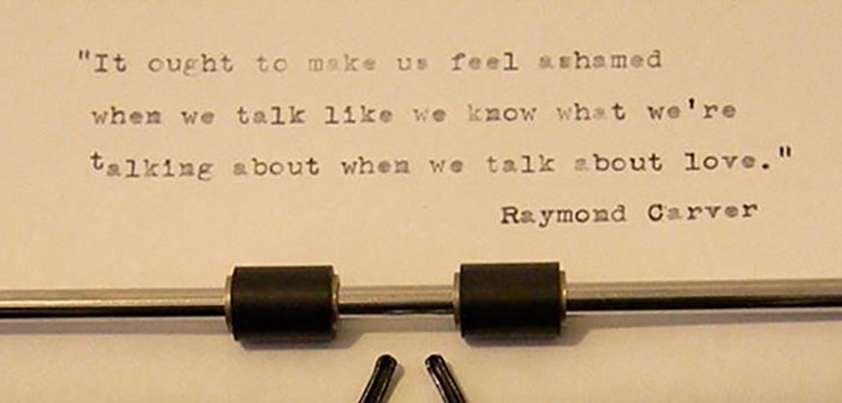 The power of this minimalist story from Raymond Carver about the difficulty of defining “real” love lies in its realism. The two couples involved in the alcohol-fueled conversation are not experts; each member has experienced a failed marriage. None of them can describe love, but they do manage to give examples of what it is and isn’t, and what can go wrong when it ends. The mood darkens along with the emptying bottle, and by story’s end all four are too despondent to move. Themes: the nature of love, the limits of language, marriage and divorce, alcohol abuse. More…
The power of this minimalist story from Raymond Carver about the difficulty of defining “real” love lies in its realism. The two couples involved in the alcohol-fueled conversation are not experts; each member has experienced a failed marriage. None of them can describe love, but they do manage to give examples of what it is and isn’t, and what can go wrong when it ends. The mood darkens along with the emptying bottle, and by story’s end all four are too despondent to move. Themes: the nature of love, the limits of language, marriage and divorce, alcohol abuse. More…
To Build a Fire
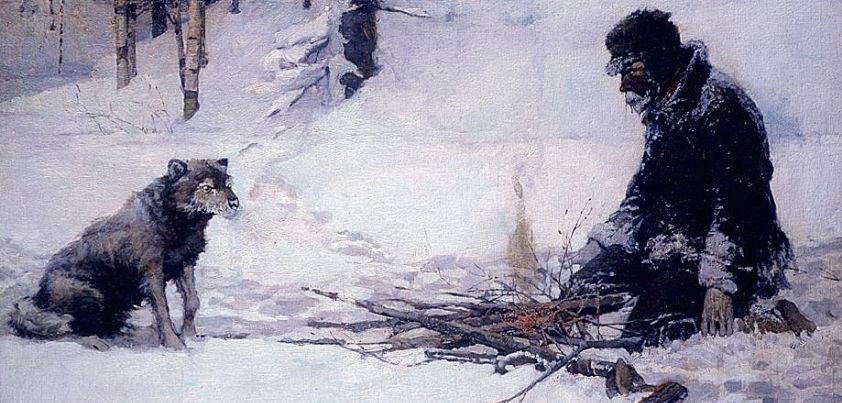 Jack London is one of the leading authors in a literary style called “naturalism”. Such stories deal with the unforgiving power of nature and man’s struggle for survival. To Build a Fire takes place in the frozen wilds of Alaska. A poorly prepared prospector decides to return to his camp in dangerously cold weather conditions, ignoring advice from more experienced men never to travel through the snow alone. A single foolish mistake brings disaster and the most comfortable and satisfying sleep he had ever known. Themes include survival (man vs. nature), listening to advice, preparedness, instinct vs. intellect, death. More…
Jack London is one of the leading authors in a literary style called “naturalism”. Such stories deal with the unforgiving power of nature and man’s struggle for survival. To Build a Fire takes place in the frozen wilds of Alaska. A poorly prepared prospector decides to return to his camp in dangerously cold weather conditions, ignoring advice from more experienced men never to travel through the snow alone. A single foolish mistake brings disaster and the most comfortable and satisfying sleep he had ever known. Themes include survival (man vs. nature), listening to advice, preparedness, instinct vs. intellect, death. More…
Witness for the Prosecution
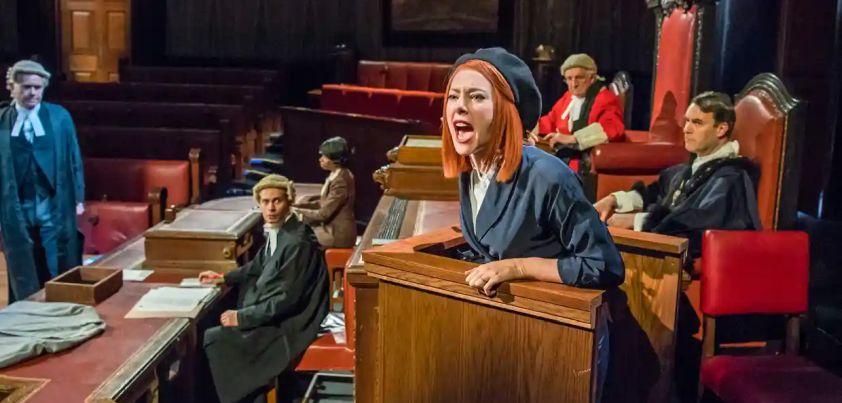 This classic crime thriller from Agatha Christie is better known for its screen and theater adaptions than the short story upon which they are based. There is no Hercule Poirot type detective here. The man charged with finding evidence to free a prisoner he is convinced was wrongly arrested for murder is a dogged solicitor. Things look grim when the man’s wife agrees to testify against him. Fortunately, a letter delivered the day before the trial leads to critical evidence that frees the man. Strangely, the solicitor is unlikely to be happy with the outcome. Themes: justice, deception, betrayal, perception. More…
This classic crime thriller from Agatha Christie is better known for its screen and theater adaptions than the short story upon which they are based. There is no Hercule Poirot type detective here. The man charged with finding evidence to free a prisoner he is convinced was wrongly arrested for murder is a dogged solicitor. Things look grim when the man’s wife agrees to testify against him. Fortunately, a letter delivered the day before the trial leads to critical evidence that frees the man. Strangely, the solicitor is unlikely to be happy with the outcome. Themes: justice, deception, betrayal, perception. More…
This is What It Means to Say Phoenix, Arizona
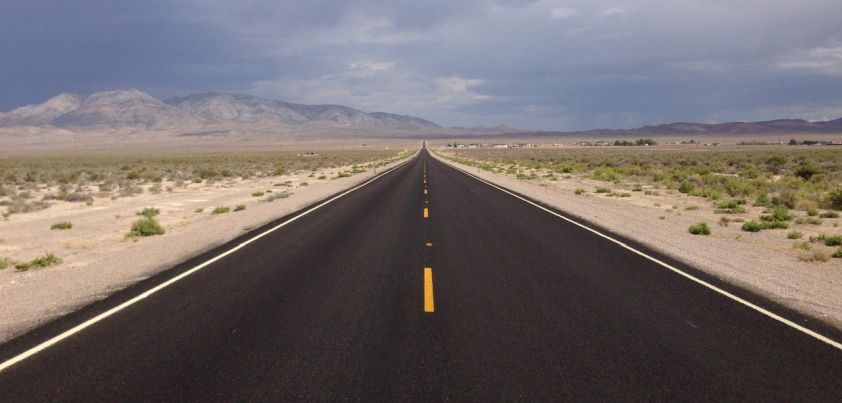 In this story by Sherman Alexie a young Native-American man enlists the help of a boyhood friend he had grown away from to go on a road trip to bring back his father’s ashes. The focus of the story is the relationship between the two, and how it reflects growing individual and cultural disconnection among tribal Native-Americans. The other man’s help is not in recognition of their former friendship, but rather out of obligation for a deed of kindness once performed by the dead man. Themes include poverty, storytelling, friendship, alienation, loneliness, forgiveness, decline of Native-American culture. More…
In this story by Sherman Alexie a young Native-American man enlists the help of a boyhood friend he had grown away from to go on a road trip to bring back his father’s ashes. The focus of the story is the relationship between the two, and how it reflects growing individual and cultural disconnection among tribal Native-Americans. The other man’s help is not in recognition of their former friendship, but rather out of obligation for a deed of kindness once performed by the dead man. Themes include poverty, storytelling, friendship, alienation, loneliness, forgiveness, decline of Native-American culture. More…
The Library of Babel
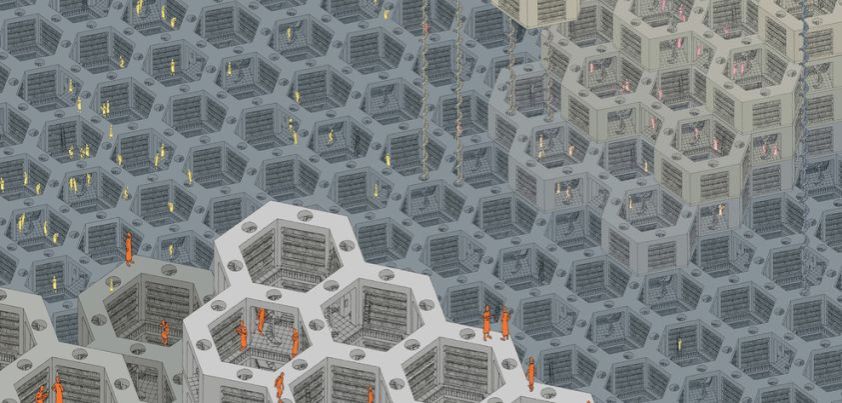 Jorge Borges is known for his unusual and sometimes complex stories which connect things that don’t seem real or possible with the themes of metaphysics and religion. The Library of Babel also includes several other themes commonly found in Borges’s work: infinity, language and order vs. randomness. The Library, which is composed of a seemingly endless number of galleries, is an allegory for the universe. The books within the galleries are incomprehensible. The librarians, who represent mankind, search for the gallery of a mythical “Man of Books” (God?), thought to contain a compendium volume which may unlock the Library’s secrets. More…
Jorge Borges is known for his unusual and sometimes complex stories which connect things that don’t seem real or possible with the themes of metaphysics and religion. The Library of Babel also includes several other themes commonly found in Borges’s work: infinity, language and order vs. randomness. The Library, which is composed of a seemingly endless number of galleries, is an allegory for the universe. The books within the galleries are incomprehensible. The librarians, who represent mankind, search for the gallery of a mythical “Man of Books” (God?), thought to contain a compendium volume which may unlock the Library’s secrets. More…
In the Cemetery Where Al Jolson Is Buried
 Given the subject matter (a woman having difficulty coming to grips with a friend’s terminal illness), one would expect this Amy Hempel story to be a maudlin tale. However, the author’s minimalist style, interspersed with quirky humor, lightens the mood considerably without losing emotional impact. The major theme of the story is fear of death. This leads to avoidance. The protagonist visits her friend only once during her months in hospital. The two evade serious conversation, speaking almost exclusively about trivia and, instead of staying the night as expected, the friend hastens away. Other themes: friendship, abandonment, guilt, grief. More…
Given the subject matter (a woman having difficulty coming to grips with a friend’s terminal illness), one would expect this Amy Hempel story to be a maudlin tale. However, the author’s minimalist style, interspersed with quirky humor, lightens the mood considerably without losing emotional impact. The major theme of the story is fear of death. This leads to avoidance. The protagonist visits her friend only once during her months in hospital. The two evade serious conversation, speaking almost exclusively about trivia and, instead of staying the night as expected, the friend hastens away. Other themes: friendship, abandonment, guilt, grief. More…
Sacred Duty / Mugaddas Farz
 In this entertaining story by Ismat Chughtai, two sets of manipulative parents are put in their place after a Muslem girl opts out of an arranged marriage the day before it is due to take place and elopes with a Hindu boy. For the marriage to be recognized as Hindu, the boy’s parents pressure the girl to convert to Hinduism. To save face, her parents later pressure the boy to convert to Islam and the girl to reconvert. Themes include interfaith marriage, generational conflict and personal freedom, manipulation, the lengths that some cultures will go to preserve family honor. More…
In this entertaining story by Ismat Chughtai, two sets of manipulative parents are put in their place after a Muslem girl opts out of an arranged marriage the day before it is due to take place and elopes with a Hindu boy. For the marriage to be recognized as Hindu, the boy’s parents pressure the girl to convert to Hinduism. To save face, her parents later pressure the boy to convert to Islam and the girl to reconvert. Themes include interfaith marriage, generational conflict and personal freedom, manipulation, the lengths that some cultures will go to preserve family honor. More…
The Jewels / False Gems
 This tongue-in-cheek story by Guy de Maupassant could be said to reflect two English proverbs: ignorance is bliss, and money can’t buy happiness. A recently widowed man of modest means is shocked to learn that his seemingly perfect wife had been living a decadent secret life. When he discovers that her “fake” jewels are real, he quits his job, becomes a man of leisure, and remarries a “very virtuous” woman who causes him much sorrow. The story introduces several important themes: appearances (things aren’t always as they seem), infidelity, vanity, hypocrisy, French bourgeois morality, exploitation of the working class. More…
This tongue-in-cheek story by Guy de Maupassant could be said to reflect two English proverbs: ignorance is bliss, and money can’t buy happiness. A recently widowed man of modest means is shocked to learn that his seemingly perfect wife had been living a decadent secret life. When he discovers that her “fake” jewels are real, he quits his job, becomes a man of leisure, and remarries a “very virtuous” woman who causes him much sorrow. The story introduces several important themes: appearances (things aren’t always as they seem), infidelity, vanity, hypocrisy, French bourgeois morality, exploitation of the working class. More…
The Heavenly Christmas Tree
 This famous Christmas story is from Fyodor Dostoevsky’s self-published periodical, Diary of a Writer. A young boy has recently arrived in a big city with his poverty-stricken, dying mother. On Christmas Eve the boy ventures out from their rented hovel in search of food. He is both terrified and intrigued by his experiences as he walks the streets. Hungry and freezing, he shelters behind a woodpile. He feels sudden warmth, and wakes surrounded by other happy children along with his smiling mother around Christ’s Christmas tree. Themes: poverty, isolation, class discrimination (rich vs. poor), inhumanity, suffering and death, Christianity. More…
This famous Christmas story is from Fyodor Dostoevsky’s self-published periodical, Diary of a Writer. A young boy has recently arrived in a big city with his poverty-stricken, dying mother. On Christmas Eve the boy ventures out from their rented hovel in search of food. He is both terrified and intrigued by his experiences as he walks the streets. Hungry and freezing, he shelters behind a woodpile. He feels sudden warmth, and wakes surrounded by other happy children along with his smiling mother around Christ’s Christmas tree. Themes: poverty, isolation, class discrimination (rich vs. poor), inhumanity, suffering and death, Christianity. More…
The Company of Wolves
 The early part of Angela Carter’s Company of Wolves comprises background and several anecdotes which build anticipation and atmosphere. The main story, which doesn’t start until one-third of the way through the text, is an adult-oriented adaption of Charles Perrault’s Little Red Riding Hood. Carter reinforces Perrault’s original theme through eroticism. The addition of the wolf choir outside the cabin (“Who has come to sing us carols, she said.” “Those are the voices of my brothers, darling; I love the company of wolves.”) reflects the feminist view (and Carter’s?) that all men have an innate desire to deflower young women. More…
The early part of Angela Carter’s Company of Wolves comprises background and several anecdotes which build anticipation and atmosphere. The main story, which doesn’t start until one-third of the way through the text, is an adult-oriented adaption of Charles Perrault’s Little Red Riding Hood. Carter reinforces Perrault’s original theme through eroticism. The addition of the wolf choir outside the cabin (“Who has come to sing us carols, she said.” “Those are the voices of my brothers, darling; I love the company of wolves.”) reflects the feminist view (and Carter’s?) that all men have an innate desire to deflower young women. More…
The Luck of Roaring Camp
 In this story by Bret Harte, strange things happen when a Californian gold prospecting camp “adopts” an orphaned baby born to its only woman resident, the camp prostitute. The birth brings a streak of good fortune to the camp, resulting in the baby being named Thomas Luck. The Luck’s presence inspires the men to clean up the camp, their habits, and themselves. The camp prospers, and there is even talk of encouraging families to move there for the sake of the child. Unfortunately, the Luck’s luck cannot defeat nature. Themes: isolation, lawlessness, community, change/redemption, the inconstancy of luck. More…
In this story by Bret Harte, strange things happen when a Californian gold prospecting camp “adopts” an orphaned baby born to its only woman resident, the camp prostitute. The birth brings a streak of good fortune to the camp, resulting in the baby being named Thomas Luck. The Luck’s presence inspires the men to clean up the camp, their habits, and themselves. The camp prospers, and there is even talk of encouraging families to move there for the sake of the child. Unfortunately, the Luck’s luck cannot defeat nature. Themes: isolation, lawlessness, community, change/redemption, the inconstancy of luck. More…
The Jay
 The Jay is one of Yasunari Kawabata’s famous Palm-of-the-Hand Stories. A small bird is causing a fuss because it can’t find a lost chick that has fallen from its nest. A young woman about to enter into an arranged marriage also feels lost. She has never known her birth mother, who her father divorced when she was very young, and lives with her grandmother. Her father and stepmother are coming to visit with the mother of her fiancé. The major theme, exemplified by the bird, is the intensity of motherly love. Other themes: family, marriage, uncertainty, wisdom of the aged. More…
The Jay is one of Yasunari Kawabata’s famous Palm-of-the-Hand Stories. A small bird is causing a fuss because it can’t find a lost chick that has fallen from its nest. A young woman about to enter into an arranged marriage also feels lost. She has never known her birth mother, who her father divorced when she was very young, and lives with her grandmother. Her father and stepmother are coming to visit with the mother of her fiancé. The major theme, exemplified by the bird, is the intensity of motherly love. Other themes: family, marriage, uncertainty, wisdom of the aged. More…
Diary of a Madman
 Lu Xun‘s diarist suffers from paranoia, stemming from strange looks he thinks he is getting from fellow villagers. On learning of an act of ritual cannibalism in a neighboring village, he concludes that those around him, including his own brother, are planning to make a meal of him. The story has several interpretations. The most common is that it satirizes the outdated Confucian traditions of Chinese feudal society. An opposing view is that it cautions the May Fourth period’s New Culture Movement against indiscriminately overturning (eating) all past traditions. Themes: madness, cannibalism, tradition, betrayal. More…
Lu Xun‘s diarist suffers from paranoia, stemming from strange looks he thinks he is getting from fellow villagers. On learning of an act of ritual cannibalism in a neighboring village, he concludes that those around him, including his own brother, are planning to make a meal of him. The story has several interpretations. The most common is that it satirizes the outdated Confucian traditions of Chinese feudal society. An opposing view is that it cautions the May Fourth period’s New Culture Movement against indiscriminately overturning (eating) all past traditions. Themes: madness, cannibalism, tradition, betrayal. More…
The Looking-Glass
 In this story by Anton Chekhov, a young woman dreams 24/7 about getting married and settling down with the perfect man. One night, while sitting in front of her looking-glass, she has a vision of what the future may hold. She sees the reality of living and raising a family in rural Russia in the late 1800s. The vision encompasses many of Chekhov’s common themes: love, hope, disease, fear, financial struggle, the challenges of parenthood, death and despair. The woman’s cry of Why is it, what is it for? introduces a final theme: disillusionment. Her dream has become a nightmare. More…
In this story by Anton Chekhov, a young woman dreams 24/7 about getting married and settling down with the perfect man. One night, while sitting in front of her looking-glass, she has a vision of what the future may hold. She sees the reality of living and raising a family in rural Russia in the late 1800s. The vision encompasses many of Chekhov’s common themes: love, hope, disease, fear, financial struggle, the challenges of parenthood, death and despair. The woman’s cry of Why is it, what is it for? introduces a final theme: disillusionment. Her dream has become a nightmare. More…
The Masque of the Red Death
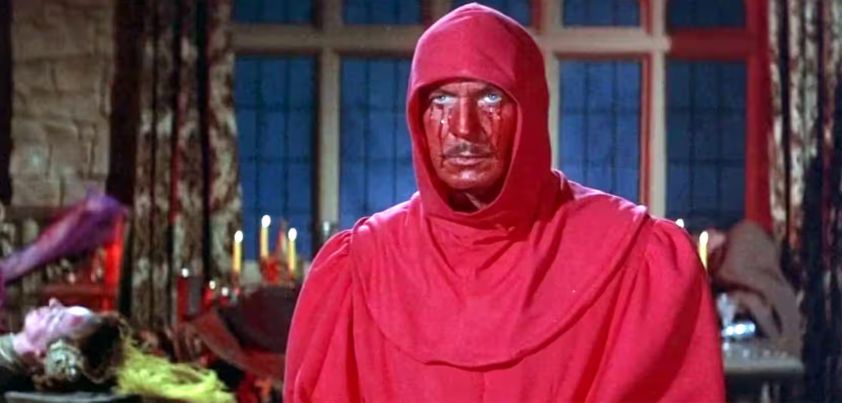 In this Edgar Allan Poe classic an eccentric, possibly mad prince of an unnamed country hopes to evade a plague known as the “Red Death” by locking himself inside a secluded abbey. Being a fun-loving fellow, he brings along an entourage comprising a thousand hale and light-hearted friends from among the knights and dames of his court and an unspecified number of servants and entertainers. They have a jolly time culminating in a lavish masquerade ball where the Red Death incarnate joins the party. Themes include the inevitability of death, fear, social class (abandonment of the common people), foolishness (madness?). More…
In this Edgar Allan Poe classic an eccentric, possibly mad prince of an unnamed country hopes to evade a plague known as the “Red Death” by locking himself inside a secluded abbey. Being a fun-loving fellow, he brings along an entourage comprising a thousand hale and light-hearted friends from among the knights and dames of his court and an unspecified number of servants and entertainers. They have a jolly time culminating in a lavish masquerade ball where the Red Death incarnate joins the party. Themes include the inevitability of death, fear, social class (abandonment of the common people), foolishness (madness?). More…
Spunk
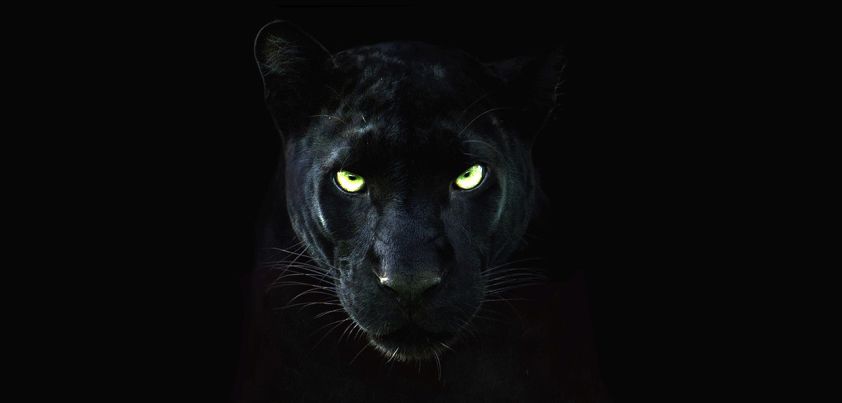 In Zora Neale Hurston’s Spunk, a mild-mannered man (Joe) is killed when he bravely but foolishly confronts his cheating wife and her macho lover. The story raises some interesting questions. Did Joe act out of love for his wife, or shame because she had humiliated him? Why did he stop at a store on the way? Was he hoping the “loungers” would talk him out of going, and too weak to back down when one of them encouraged him? Finally, who or what caused Spunk to fall into the saw? Themes include love and passion, courage and fear, the supernatural. More…
In Zora Neale Hurston’s Spunk, a mild-mannered man (Joe) is killed when he bravely but foolishly confronts his cheating wife and her macho lover. The story raises some interesting questions. Did Joe act out of love for his wife, or shame because she had humiliated him? Why did he stop at a store on the way? Was he hoping the “loungers” would talk him out of going, and too weak to back down when one of them encouraged him? Finally, who or what caused Spunk to fall into the saw? Themes include love and passion, courage and fear, the supernatural. More…
The Man to Send Rain Clouds
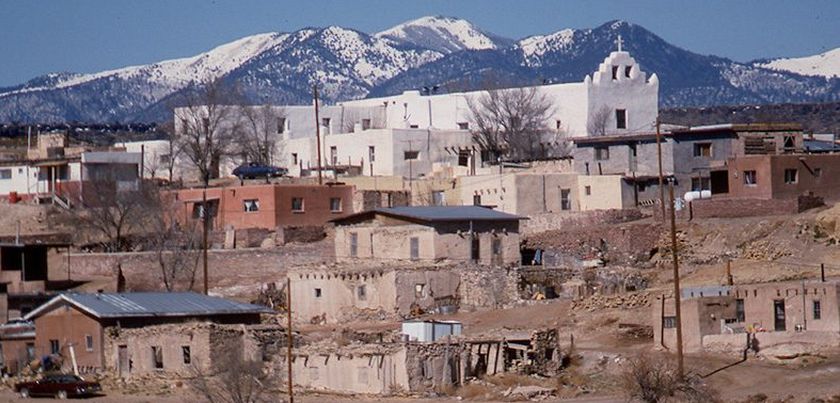 This playful story by Leslie Marmon Silko illustrates how two cultures, one indigenous and very much attached to their land, the other foreign and dominant, coexist. When an aging Pueblo Native American dies tending their sheep, his people plan to give him a traditional tribal burial. They deceive a young Catholic priest, who would have insisted on a Christian ceremony, but later find they need something from him. Themes include death, tradition, adaptability (by the tribe as a means of mitigating culture clash) and flexibility (by the priest as a means of being accepted into the community). More…
This playful story by Leslie Marmon Silko illustrates how two cultures, one indigenous and very much attached to their land, the other foreign and dominant, coexist. When an aging Pueblo Native American dies tending their sheep, his people plan to give him a traditional tribal burial. They deceive a young Catholic priest, who would have insisted on a Christian ceremony, but later find they need something from him. Themes include death, tradition, adaptability (by the tribe as a means of mitigating culture clash) and flexibility (by the priest as a means of being accepted into the community). More…
The Monkey’s Paw
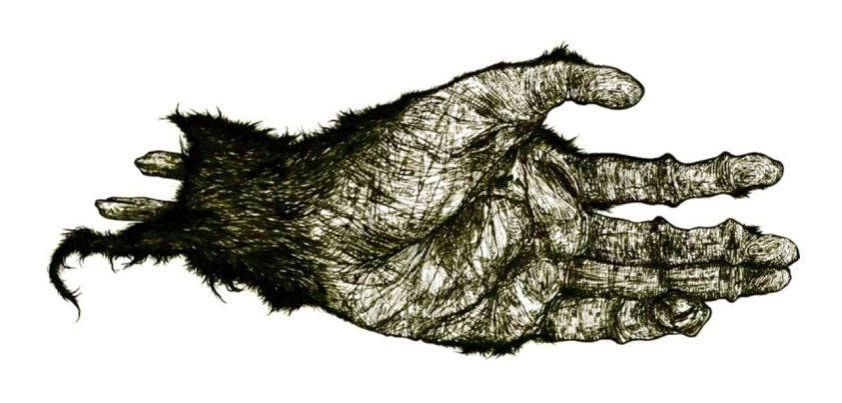 Today we are bringing you The Monkey’s Paw by W. W. Jacobs, one of the most famous horror stories of all time. First published in 1902, it has since appeared in many forms including live plays, movies, TV shows, radio plays, books, comics and cartoons (even a Simpsons episode!). In the story, a man makes a wish upon an enchanted monkey’s paw with disastrous results for his family. First, some advice before you start to read. Don’t do it sitting at home alone on a dark and stormy night! Themes: family, greed, tempting fate, industrialization (work safety), death, the supernatural. More…
Today we are bringing you The Monkey’s Paw by W. W. Jacobs, one of the most famous horror stories of all time. First published in 1902, it has since appeared in many forms including live plays, movies, TV shows, radio plays, books, comics and cartoons (even a Simpsons episode!). In the story, a man makes a wish upon an enchanted monkey’s paw with disastrous results for his family. First, some advice before you start to read. Don’t do it sitting at home alone on a dark and stormy night! Themes: family, greed, tempting fate, industrialization (work safety), death, the supernatural. More…
Inem
 This story by Pramoedya Ananta Toer is set in 1930s Java. A six-year-old boy’s best friend, an eight-year-old girl, is married off to a seventeen-year-old-man. The naïve girl, who has no idea what marriage entails, is excited only because of the new clothes and make-up she will wear at the ceremony. Her family are neighbors, and for months afterward the boy is kept awake by her screams at night. A year later she is divorced, a tainted “woman” facing a miserable future. Themes include cultural tradition, innocence, friendship, child marriage, brutality, patriarchy, shame, compassion vs. social correctness. More…
This story by Pramoedya Ananta Toer is set in 1930s Java. A six-year-old boy’s best friend, an eight-year-old girl, is married off to a seventeen-year-old-man. The naïve girl, who has no idea what marriage entails, is excited only because of the new clothes and make-up she will wear at the ceremony. Her family are neighbors, and for months afterward the boy is kept awake by her screams at night. A year later she is divorced, a tainted “woman” facing a miserable future. Themes include cultural tradition, innocence, friendship, child marriage, brutality, patriarchy, shame, compassion vs. social correctness. More…
The Undertaker / Coffin-Maker
 Many readers feel let down by this gloomy Alexander Pushkin story because of its seemingly abrupt ending. A Russian undertaker moves house to a more affluent Moscow suburb of predominantly German artisans. Invited to a neighbor’s party, he over-indulges in wine. After taking a proposed toast to his “corpses” as an insult to his profession, he threatens to have his own celebration the next day for those for whom I work: the orthodox dead. He wakes to find that his threat has become a reality. Or has it? Themes: life and death; racial, professional and religious prejudice; insecurity; unethical conduct/cheating. More…
Many readers feel let down by this gloomy Alexander Pushkin story because of its seemingly abrupt ending. A Russian undertaker moves house to a more affluent Moscow suburb of predominantly German artisans. Invited to a neighbor’s party, he over-indulges in wine. After taking a proposed toast to his “corpses” as an insult to his profession, he threatens to have his own celebration the next day for those for whom I work: the orthodox dead. He wakes to find that his threat has become a reality. Or has it? Themes: life and death; racial, professional and religious prejudice; insecurity; unethical conduct/cheating. More…